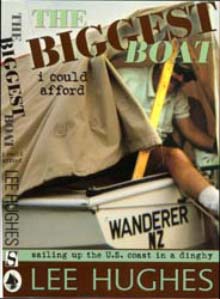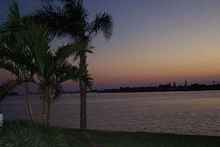| A few weeks ago, while sitting in
the nearly completed cockpit of my Stevenson Pocket Cruiser and
swiveling my newly cut tiller, I was struck by the sudden realization
that I can see the finish line. It’s still far away, but
it’s real and for the first time I know I will make it.
With the hull and cabin completed I am now building the rudder,
hatch, and other details that make the boat look even more like
a boat. A great deal of work remains, of course, but the list
is not impossibly long. As my “to do” list shrinks,
my confidence grows.
“What do you know,” I said out loud, genuinely amazed.
“I’m going sailing.”
It’s time to seriously research my long planned cruise.
As I mentioned last month, my interest in boat building was inspired
by fantasies of adventures in the South Seas. But I reigned in
this unrealistic dream and I settled for a small boat and a vague
idea of exploring protected waters closer to home. However, my
preoccupation with building kept me from investigating my options.
But as my boat takes shape, it’s time to plan my itinerary.
As a resident of southeastern Pennsylvania, the logical place
to start is the Chesapeake Bay, and that will almost certainly
be my “home port.” Truthfully, the Bay’s countless
inlets and islands could occupy me for years. But why stop there?
For inland sailors, the Chesapeake is only one part of an interconnected
network of canals, bays, lakes and rivers that encircle the eastern
half of North America. Collectively they form a 6,000 mile ribbon
of water known as the Great Loop. The idea of dropping my boat
in the water and ending up in, say, the Everglades or the Great
Lakes is almost irresistible.
But it’s also true that I probably won’t undertake
the whole trip—at least not for a while. So with a small
boat and limited time (let’s say a month or two), what portions
of the Loop are most worth exploring?
I began by investigating the most famous (and probably most traveled)
part of this inland passage—the Intracoastal Waterway. Following
a series of canals and bays, it provides a nautical Interstate
95 linking New York to Florida.
|
The Intracoastal Waterway |
I have happy associations with this southern migration. As a
boy, my family drove every winter from our home in Albany, New
York to a beachfront hotel in Florida. This was before the highways
were finished, so much of the trip was made on back roads. I vividly
recall the delicious sensation of leaving the winter landscape
of upstate New York and watching, with growing excitement, as
the scenery evolved from the familiar to the exotic. First the
snow thinned, then disappeared. Then the grass turned green and
the air turned warm. On two lane roads of Georgia and north Florida,
I searched for orange trees and Spanish moss. By the night of
the second day, I smelled sea air through the open windows of
our station wagon. We had arrived.
Now I dream of recapturing this drama of incremental change along
the ICW. I imagine beginning in the northern edges of the Chesapeake
during the last warm days of autumn and entering the Intracoastal
somewhere near Norfolk, Virginia. From the safety of a well marked
canal I sail and motor (as necessary), but at a leisurely pace.
I stop for the night at inlets, dock at interesting towns for
provisions, and chat with fellow sailors along the way. As the
weeks pass, I spy palmetto, palms, and mangroves. Just as the
mid-Atlantic has its first hard frost, I am sunning myself somewhere
near Key West. I’m six years old again, looking for shells
on a warm beach without a care in the world.
That’s the fantasy. But what is the reality? With no direct
experience, I rely on books and blogs. Opinions vary, but it’s
clear that the “Ditch” inspires both affection and
loathing among those who know it best.
To my first question—can the ICW be safely traveled in
a small boat? —the answer seems to be a qualified “yes.”
Boats much smaller than mine have made the journey. One of the
boat designers I admire most, Matt Layden, built a series of “mircocruisers”
no larger than my Pocket Cruiser. Several have completed cruises
down the ICW. One, the 14-foot “Little Cruiser” completed
the trip eight times—10,000 miles in all, according to a
Web site
devoted to his designs.
Many others complete the journey in everything from canoes and
kayaks to daysailers. In The
Biggest Boat I Could Afford, New Zealand author
Lee Hughes chronicles his journey from Florida to Maryland in
a dinghy “not much bigger than a king size bed,” according
to the book’s jacket.
 |
The Biggest Boat I Could Afford |
Conforming to the genre, his book emphasizes various dangers,
mishaps and amusing encounters along the way. The author, a novice
sailor with a fear of the sea, was “beached, swamped, [and]
wrecked” as he blundered north, but arrived safe and sound.
But I am also learning that the Intracoastal can be tedious,
dull and even annoying. Those who have completed the route point
out that the narrow canal limits opportunities for sailing. Teresa
Carey, who is currently completing her first trip down the ICW
in her 27-foot sailboat, recently wrote on her blog that the Intracoastal
is “a great place to start, establish your routines, learn
from others, and join a network of fellow wandering sailors that
will serve as a dynamic community and safety net.” But she
adds that it “is not my kind of ‘sailing’ where
the canals are so narrow that the only way to make progress is
to motor.” (https://sailingsimplicity.com/)
There are other obstacles, as well. Commercial traffic can be
a hazard. In what is probably the first account of a sailing journey
down the ICW, Henry Plummer recounts in The
Boy, Me, and the Cat several close calls with
barges during his 1912 journey from New England to Miami. More
recently, Ron Stob, author of the self published book Honey,
Let’s Get a Boat, described feeling both
small and vulnerable while treading his 40 foot cruiser around
the barges and container ships in Norfolk. Sailors also report
encounters with floating logs and other debris large enough to
easily puncture my quarter inch hull. Everyone complains
about discourteous powerboaters.
On the other hand, I don’t need to worry about two much-discussed
hazards—bridges and shallow water. For cabin cruisers and
large sailboats, bridges are probably the most persistent source
of delay and irritation. “Most cruisers begin their inland
treks at Mile Zero, at Portsmouth, Virginia,” writes Jon
Eisberg in a 2004 issue of Cruising World. “Unfortunately,
the curse of the first 20 miles of the Ditch is the nine bridges,
each with its own opening schedule. Unless one is under way from
Mile Zero well before first light, the better part of a day will
be required to cover this distance.”
“The first 50 miles, to Coinjock, North Carolina, can seem
like a forced march,” he continues. “The push to make
the next bridge opening is constant and ever at odds with the
necessity to reduce speed to allow the never-ending flow of powerboats
to perform a courteous pass. And by the first day’s end,
you may begin to think that courtesy is all but gone from the
world.” (https://www.cruisingworld.com)
My knowledge of these obstacles is sketchy. However, I assume
that with an unstepped mast my small boat can slide underneath
most of these low-slung bridges. If so, I anticipate mild feelings
of moral superiority.
In addition, my little flat bottomed Pocket Cruiser can skim
over the shallow and insufficiently dredged channels.
|
Paul in his pocket cruiser. |
In 1912, Henry Plummer was grounded countless times in his 24-foot
sailboat. Sometimes he would work all morning to free himself
from the muck, only to hit bottom again moments later. “Continually
we ran aground,” his son recalled. “With only three
or four inches of tide, getting off meant an endless shifting
of ballast and heeling of the boat over to raise her keel. After
doing this four or five times a day, it became more than just
monotonous.”
It’s better today—but not by much. Wikipedia reports
that “federal law provides for the waterway to be maintained
at a minimum depth of 12 ft (4 m) for most of its length, but
inadequate funding has prevented that.” In some sections,
it is maintained at seven to nine foot depths—a veritable
Marianas Trench for my boat, but a problem for many larger craft.
But I still worry about feeling like the odd man out in my homemade
boat. Based on the many blogs I have investigated, the ICW’s
cruising culture appears to be dominated by retirees with enormous
cabin cruisers powering south for the winter. They sound like
a fun crowd. Cruisers look out for each other and many friendships
are formed. I get the impression that, for some, the ICW is one
long cocktail party. But I worry about feeling overwhelmed by
floating Winnebagos. Is it still possible to enjoy quiet, solitude,
and leisurely exploration of undeveloped shores?
Perhaps. While much of the route passes busy marinas and sprawling
oceanfront developments, some portions remain relatively wild
and the passage through the Great Dismal Swamp in southern Virginia
looks downright primeval. Experienced cruisers also write about
detours that allow for real sailing and exploration of quaint
towns. Those destinations, alone, would make the trip worthwhile.
 |
Scenes sailing voyages entail. |
Still, I’m not ready to pack my bags. There are several
other options worth investigating. If the Intracoastal is less
than perfect, what about taking a trip north to Canada—or
heading like a latter day Huckleberry Finn down the Mississippi?
That’s the topic of my next column.
*********** |

